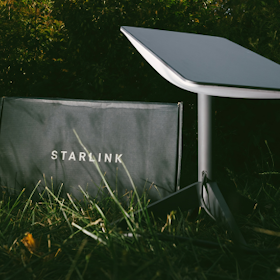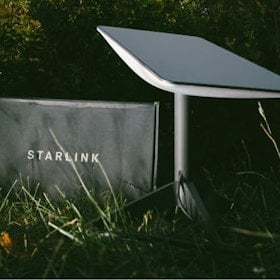
Pocket Wi-Fi can keep your portable devices safely and securely connected to the internet while you are out around town, or even when traveling internationally. You can purchase portable Wi-Fi through various retailers and cellular carriers like Rogers, Telus, and Bell.
Plans for pocket Wi-Fi data can be on the expensive side, making it a better option to supplement your internet connection, rather than being your primary source of internet. Keep reading to learn all you need to know about pocket Wi-Fi.
What’s Pocket Wi-Fi?
Pocket Wi-Fis are portable Wi-Fi devices that you can use to connect your other tech (typically a laptop) to the internet. Like the name implies, it’s like having a Wi-Fi connection in your pocket—though you obviously don’t need to actually keep it in your pocket.
You may know pocket Wi-Fi by these common names:
- Mobile hotspot
- Mobile Wi-Fi
- Wi-Fi dongle
- MiFi
- Portable Wi-Fi hotspot
- Portable Wi-Fi router
Who Needs Pocket Wi-Fi?
If you are constantly on the go and want to keep your devices connected to the internet, pocket Wi-Fi could be a good option for you.
Portable Wi-Fi is typically compatible with these devices:
- Laptops and other personal computers
- Tablets
- Smartphones
Of course, if you own a smartphone, you probably don’t need pocket Wi-Fi for it. You almost certainly have a data plan attached to it already. Many people also get a data plan for their tablets as well. Still, while these devices are usually already connected here in Canada, you could have to pay expensive fees to keep them connected abroad. In the long run, it might be cheaper to find a data plan for a pocket W-Fi to sync up with your smartphone.
Most practically, people use pocket Wi-Fi to connect their laptops to the internet. Pocket Wi-Fi can give you a secure and consistent connection to help you avoid relying on public Wi-Fi connections.
Can pocket Wi-Fi replace home internet?
Probably not. The biggest issue is that data for mobile Wi-Fi costs a lot of money. For the price of about 20GB of high-speed data for your pocket Wi-Fi, you could get faster and much more reliable home internet access. Because of this, we recommend pocket Wi-Fi only for those who plan to use it regularly while outside the house or for those who travel and want to ensure they have internet abroad.
Pocket Wi-Fi vs. Your Cell Phone
Your phone plan likely includes mobile hotspot data that allows you to use your cell phone as a Wi-Fi hotspot. So, what’s the difference between your phone’s hotspot capabilities and pocket Wi-Fi? On the surface, not a whole lot. Both use cellular data to allow you to connect other devices to the internet.
Looking deeper, however, you’ll find some advantages of using a pocket Wi-Fi device rather than just using your cell phone:
- You don’t have to drain your phone’s battery.
- Pocket Wi-Fi is typically faster.
- You can connect more devices on a pocket Wi-Fi.
If you don’t plan on using pocket Wi-Fi often, your phone’s hotspot will probably suffice. Most Canadian phone plans allow for hotspot tethering, and you can add on a data-only plan to allow for dedicated hotspot access.
Where to Get Pocket Wi-Fi
You can get pocket Wi-Fi pretty much anywhere you can purchase a cell phone. This includes all of the major cell phone carriers and several of the smaller mobile virtual network operators (MVNOs).
Additionally, several big retailers sell pocket Wi-Fi and mobile hotspot devices, and you can find reputable options on Amazon. We've listed a few of our favorites below.
Best Pocket Wi-Fi Devices
A few of the best portable Wi-Fi devices include:
- Skyroam Solis X
- This portable Wi-Fi can connect up to 10 devices simultaneously with 16 hours of battery life while fitting snugly in your pocket. Enjoy 4G LTE speeds on nearby networks, as well as additional features such a microphone and audio speakers, a remote camera, Bluetooth connectivity, and a power charging bank.
- GlocalMe
- The GlocalMe portable Wi-Fi offers connectivity for up to 15 hours, with the ability to power up to 5 devices at once. You can use it with the included data or you can pop in your own SIM card to take advantage of your phone plan's hotspot data. GlocalMe can support high-speed 4G LTE speeds and, like the Skyroam Solis, has a charging power bank built in.
- RoamWifi R10
- With the RoamWifi pocket hotspot, you can keep up to 5 devices connected for up to 18 hours. Its local data package option includes up to 100GB of data in Canada—plenty to support your on-the-go lifestyle whether you're working from a cafe or hiking in the backcountry. And as indicated in its name, RoamWifi also supports network roaming to ensure you're never stranded without a connection.
Pocket Wi-Fi Plans
Many of the major Canadian wireless carriers offer data-only plans for mobile Wi-Fi devices, as well as standard plans that offer plenty of guaranteed high-speed data to use as your Wi-Fi hotspot. Prices vary based on data limits. Here are some excellent options for data-only and by-the-gig phone plans.
More Travel Options
As you can see from the plans we’ve already highlighted, you have options when it comes to traveling internationally with your pocket Wi-Fi. One other option (that might be cheaper) is taking your portable Wi-Fi hotspot device with you and buying a SIM card from the country you visit. Do a little research before you make your trip to see if there are affordable international SIM card options available for you.
Is public Wi-Fi safe?
From coffee shops to your favorite local park, you can find public Wi-Fi just about everywhere. However, warnings about the poor security of public Wi-Fi might make you very apprehensive to connect to it. While such warnings held validity in the past, many of those concerns no longer exist, largely due to encryption adapted by nearly 90% of the web—and practically all websites the average user visits.
Websites that start with “https” and/or the locked padlock symbols are sites that encrypt the data that goes back and forth between the site and your computer. This is the vulnerable data that nefarious people on public Wi-Fi would attempt to intercept. Encryption jumbles up this data, making it pretty much impossible for the interceptors to translate and find any value from it.
Encryption through secure websites has made public Wi-Fi safer than ever before. But remember that not everything on the web uses encryption, and you probably still have plenty of unsecured files on your computer. Public Wi-Fi is generally safe, but not completely safe.
Related Articles
Find Better Internet and Phone Plans
Hundreds of internet plans unpacked. All the facts. No surprises.
Internet Providers by Provinces and Territories
- Internet in Alberta
- Internet in British Columbia
- Internet in Manitoba
- Internet in New Brunswick
- Internet in Newfoundland and Labrador
- Internet in Northwest Territories
- Internet in Nova Scotia
- Internet in Nunavut
- Internet in Ontario
- Internet in Prince Edward Island
- Internet in Quebec
- Internet in Saskatchewan
- Internet in Yukon Territory




































